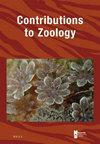Integrative systematics illuminates the relationships in two sponge-associated hydrozoan families (Capitata: Sphaerocorynidae and Zancleopsidae)
IF 2.2
2区 生物学
Q1 ZOOLOGY
引用次数: 4
Abstract
An integrated approach using morphological and genetic data is needed to disentangle taxonomic uncertainties affecting the hydrozoan families Sphaerocorynidae and Zancleopsidae. Here we used this approach to accurately characterise species in these families, identify the previously unknown polyp stages of the genera Euphysilla and Zancleopsis, which were originally described exclusively based on the medusa stages, describe a new sphaerocorynid genus and species, and assess the phylogenetic position of the two families within the Capitata. The monotypic genus Astrocoryne was found to be a synonym of Zancleopsis. Astrocoryne cabela was therefore transferred to the genus Zancleopsis as Zancleopsis cabela comb. nov. The new polyp-based genus and species Kudacoryne diaphana gen. nov. sp. nov. was erected within the Sphaerocorynidae. Both taxa are primarily based on genetic data, but the introduction of this new genus was made necessary by the fact that it clustered with the genera Heterocoryne and Euphysilla, despite showing Sphaerocoryne-like polyps. Interestingly, the species analysed in this work showed contrasting biogeographical patterns. Based on our data and literature records, some species appear to have a wide circumtropical range, whereas others are limited to few localities. Overall, these results lay the ground for future investigations aimed at resolving the taxonomy and systematics of these two enigmatic families.综合系统学阐明了两个与海绵相关的水生动物科(Capitata:鞘翅科和Zancleopskidae)的关系
需要一种利用形态学和遗传学数据的综合方法来理清影响水生动物科鞘翅目和Zancleopskie的分类学不确定性。在这里,我们使用这种方法准确地描述了这些科中的物种,确定了Euphysila属和Zancleopsis属以前未知的息肉阶段,这些阶段最初仅基于水母阶段进行描述,描述了一个新的蝶冠属和物种,并评估了这两个科在Capita中的系统发育位置。单型属Astrocoryne被发现是Zancleopsis的异名。因此,Astrochryne cabela被转移到Zancleopsis属,称为Zancleypsis cabela comb。新的以息肉为基础的属和种Kudacoryne diaphana gen.nov.sp.nov.是在鞘翅科中建立的。这两个分类群主要基于遗传数据,但引入这个新属是必要的,因为它与异珊瑚属和Euphysila属聚集在一起,尽管显示出类似鞘翅目的息肉。有趣的是,这项工作中分析的物种显示出截然不同的生物地理模式。根据我们的数据和文献记录,一些物种似乎有广泛的环热带范围,而另一些物种则局限于少数地区。总的来说,这些结果为未来旨在解决这两个神秘家族的分类学和系统学的研究奠定了基础。
本文章由计算机程序翻译,如有差异,请以英文原文为准。
求助全文
约1分钟内获得全文
求助全文
来源期刊

Contributions to Zoology
生物-动物学
CiteScore
4.00
自引率
4.50%
发文量
16
审稿时长
>12 weeks
期刊介绍:
Contributions to Zoology solicits high-quality papers in all systematics-related branches of comparative zoology (including paleozoology). Preference will be given to manuscripts dealing with conceptual issues and to integrative papers (e.g., ecology and biodiversity, morphology and phylogeny and character state evolution, phylogeny and historical biogeography, systematics and bioinformatics, bioinformatics and biodiversity, habitat disturbance and biogeography, etc.). Reviews and alpha-taxonomic contributions are considered for publication, but acceptance will depend on their high quality and exceptional nature.
 求助内容:
求助内容: 应助结果提醒方式:
应助结果提醒方式:


